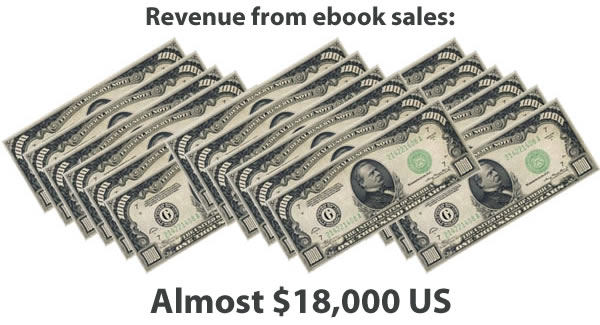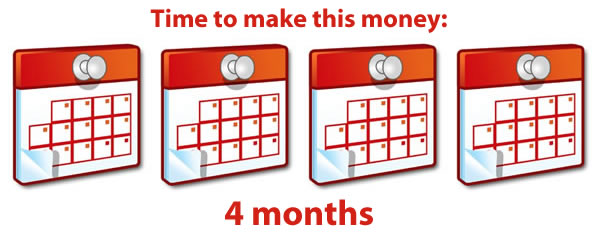Starting late this afternoon Central Time, I’ll be reporting from Big Omaha, the startup conference that Philip “Pud” Kaplan has described as “SxSW before SxSW got insane” and waving the Shopify flag there. Keep an eye on this blog for my notes from the sessions, which are legendary!
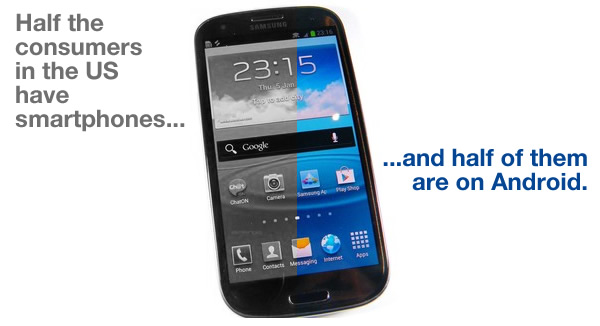
When it rains, it pours. Just hours after I published my article on the way-off predictions on how well Windows Phone would do and cited the comScore numbers for mobile OS market share, Nielsen releases their findings, which are pretty similar. According to their survey, 50.4% of US consumers have a smartphone, and of those people, 48.5% are using Android phones.
Unlike comScore, Nielsen treated Windows Mobile, the older mobile OS versions 6.5 and earlier, and Windows Phone, as two separate operating systems. comScore had both operating systems at 3.9% of the market; Nielsen says that Windows Mobile accounts for 4.1% and Windows Phone, Microsoft’s “comeback” mobile OS, has just 1.7%. If I were still a Windows Phone Champ today, I’d be at my local pub, pounding back the bourbon something fierce.

Nielsen took in all sorts of info in their survey of mobile phone use, including a by-race breakdown of who used mobile phones as their primary phone. I noticed that the Asian stereotype rings true in this case and couldn’t resist making an infographic featuring me back during my Microsoft Phone Champ days alongside my homie Stevie B:
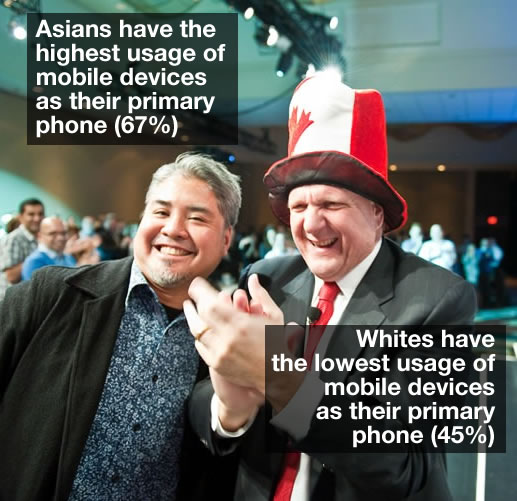
And in case you were wondering: I’m Asian (the Thrilla from Manila!) and my mobile phone is my primary phone (Skype’s my secondary). Steve Ballmer is white.
IDC’s Prediction: Almost 6% Market Share in 2011, 21% by 2015

Near the end of March 2011, IDC forecasted in their Worldwide Quarterly Mobile Phone Tracker report that by 2015, Windows Phone 7 would have leapfrogged past BlackBerry and iOS to claim the number two spot, with almost 21% market share:
| Operating System | Predicted 2011 Market Share |
Predicted 2015 Market Share |
|---|---|---|
| Android | 39.5% | 45.4% |
| BlackBerry | 14.9% | 13.7% |
| iOS | 15.7% | 15.3% |
| Symbian | 20.9% | 0.2% |
| Windows Phone 7 and Windows Mobile |
5.5% | 20.9% |
| Others | 3.5% | 4.6% |
They wrote:
Nokia’s recent announcement to shift from Symbian to Windows Phone will have significant implications for the smartphone market going forward. “Up until the launch of Windows Phone 7 last year, Microsoft has steadily lost market share while other operating systems have brought forth new and appealing experiences,” added Llamas. “The new alliance brings together Nokia’s hardware capabilities and Windows Phone’s differentiated platform. We expect the first devices to launch in 2012. By 2015, IDC expects Windows Phone to be number 2 operating system worldwide behind Android.”
Gartner’s Prediction: Almost 6% in 2011, 11% in 2012, 20% by 2015
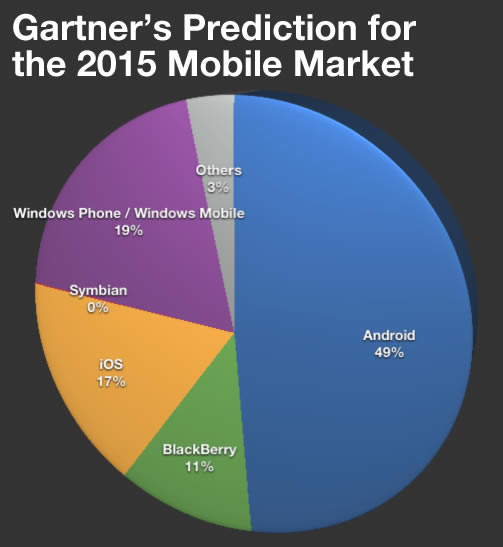
A few days later, Gartner published a press release making a similar prediction: Windows Phone would claim about a fifth of the smartphone market by the end of 2015. Here’s their breakdown:
| Operating System | Predicted 2011 Market Share |
Predicted 2012 Market Share |
Predicted 2015 Market Share |
|---|---|---|---|
| Android | 38.5% | 49.2% | 48.8% |
| BlackBerry | 13.4% | 12.6% | 11.1% |
| iOS | 19.4% | 18.9% | 17.2% |
| Symbian | 19.2% | 5.2% | 0.1% |
| Windows Phone 7 and Windows Mobile | 5.6% | 10.8% | 19.5% |
| Others | 3.9% | 3.4% | 3.3% |
They wrote:
Gartner predicts that Nokia will push Windows Phone well into the mid-tier of its portfolio by the end of 2012, driving the platform to be the third largest in the worldwide ranking by 2013. Gartner has revised its forecast of Windows Phone’s market share upward, solely by virtue of Microsoft’s alliance with Nokia. Although this is an honorable performance it is considerably less than what Symbian had achieve in the past underlying the upward battle that Nokia has to face.
Pyramid Research’s Totally Crazy-Ass Prediction: Number One in Market Share by 2015, with Nearly 40%
On May 9th, 2011 — almost a year ago to the day — came the most unbelievable of the Windows Phone predictions. Pyramid Research announced that Windows Phone’s market share would edge past Android’s, with almost 40% of the smartphone market. Here’s the graph they published, with a vertical line I added to make it easier to read the current market share:
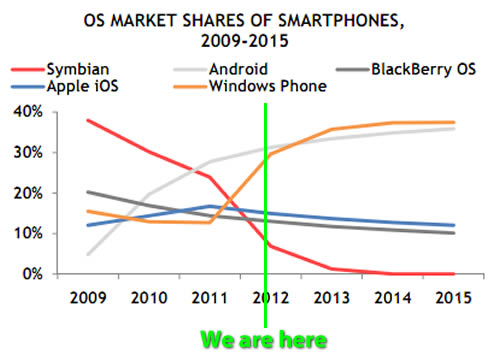
Here’s what they wrote (with additional emphasis by me):
Now, a couple of words about the “controversial” projection itself. While we acknowledge the momentum that Android is experiencing and will continue to experience in 2011 and 2012, we believe that Nokia and Microsoft are a very powerful tandem, and that will show in its full force by the end of 2013. Some of the main obstacles to the growth of WP to date will be removed, as Nokia helps with bringing down the price of WP smartphones. Lower price of the devices will be the crucial prerequisite for the expansion of WP models. Nokia knows it and Microsoft knows it, and I am sure they will act on it quickly. It’s also worth mentioning that, apart from Nokia, quite a few other large handsets vendors in the world, such as Samsung, LG and Sony Ericsson are still placing their bets on WP. With the change in the price of WP devices, and the multivendor strategic approach of Microsoft, the main advantage of Android – scale – may be removed.
And although Nokia has suffered a significant loss from dragging out the Symbian story for too long, it’s Nokia we are talking about: They are big enough and strong enough to take on a couple of painful hits and come out of the struggle stronger than ever. They are in a good position to learn and adjust because they know what was bad about Symbian, what’s creating gains and what’s causing problems for Android, as well as what the upsides and downsides of a system such as that of Apple, where the OS only runs on hardware manufactured by the vendor.
Don’t forget that while being late to the party is rude, everybody gets to see you enter the room. When Nokia “enters the room” with new WP-based devices, there will likely be much traction about its new “clothes and shoes,” which will be a good jump start for the new era of WP devices.
And Where are We Now?
IDC predicted that Windows Phone would have a 5.6% market share by the end of 2011. Gartner’s prediction was that Windows Phone would have nearly 11% of the phone market by the end of 2012. And from eyeballing Pyramid Research’s chart, Windows Phone’s market share should be about 27%.
Let’s now take a look at the latest comScore report, published on May 1st, 2012:
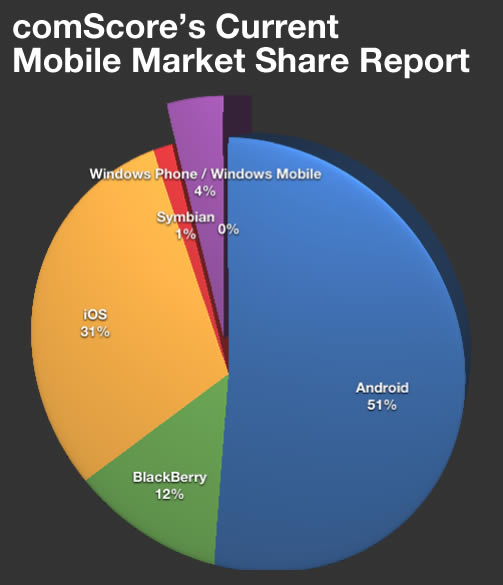
| Operating System | December 2011 Market Share |
March 2012 Market Share |
|---|---|---|
| Android | 47.3% | 51.0% |
| BlackBerry | 16.0% | 12.3% |
| iOS | 29.6% | 30.7% |
| Symbian | 1.4% | 1.4% |
| Windows Phone 7 and Windows Mobile | 4.7% | 3.9% |
Before I talk about the comScore numbers, I’d like to remind you that they need to be taken with a grain of salt.Be sure to read MG Siegler’s article about comScore’s and NPD’s numbers — while they suggest that “Android is winning”, there seems to be a lot wrong with their math when it comes to iOS’ and Android’s market shares. However, for the smaller players, it should be safe to assume that their numbers are closer to correct.
IDC’s, Gartner’s and Pyramid Research’s predictions seem to be quite near comScore’s numbers for how much market share BlackBerry’s OS would have in 2012.
When I was a Microsoft developer evangelist and one of Microsoft Canada’s Windows Phone Champs, I would’ve defined the first couple of years’ market shares predicted by Gartner — 6% by the end of 2011, 11% by the end of 2012 — as a “reasonably good” outcome, and I’d have called Windows Phone in a close tie with BlackBerry OS (with say, 15% of the market by 2012) as “awesome”. Were I still in that job today, I’d describe the current comScore numbers, and especially the drop to below 4% between December and March, as “distressing”.

Tomi Ahonen, who probably knows more about Nokia than anyone outside the company, recently wrote (once again, the emphasis is mine):
Have you braced yourself for the shock? Lets do updated (downgraded) forecast for Nokia smartphone market share, average price and revenues for 2012. The quick version? Nokia’s current 8% market share in smartphones, that was 29% just over a year ago, will fall to 3% by year-end. Nokia’s smartphone unit will not return to profits and while the industry grows by over 50% this year, Nokia’s smartphone unit revenues will be cut almost in half.
…
If you want to consider Windows Phone as the so-called 3rd ecosystem (in reality no better than 5th or 6th), then as we just heard, LG is now not continuing Windows Phone production either, following Sony’s earlier pull-out of Windows Phone commitments, this ‘Third Ecosystem’ is proving a bigger farce every day. What can you add from the Samsung and HTC partners to the above Lumia numbers. Maybe half a million per quarter if we’re lucky, more likely half that number. So your Windows Phone new sales are pretty close to what you see here. Microsoft will end 2012 selling perhaps 19 million Nokia branded smartphones, if you toss in 2 or 3 million more by all other Windows Phone partners, even 22 million will not get you more than 3% global market share of new sales and Windows Phone ‘Third Ecosystem’ would end the year with under 2% of the installed base of all smartphones. Does this smell dead to you?
The class action lawsuit against Nokia by some of its shareholders isn’t helping things, either.
What It Means for You, the Mobile Developer

Simply put, it means the predictions are dead wrong — and in Pyramid Research’s case, delusional — and you’d best run away from this platform as quickly as your feet will take you. Unless there’s some massive change in Microsoft’s strategy — maybe there’ll be a Windows 8 miracle, but I wouldn’t bet on it — do not look back, just high-tail it out of there. There’s a lot of interesting stuff happening in the mobile world, but it ain’t happening in Windows Phone land.
Windows Phone’s market share remains stuck in the single digits nearly two years after its launch. It’s well below 10%, which in my opinion is the minimum market share for a smartphone OS to remain viable, and that’s assuming that the OS has some kind of edge that the others lack. Nokia, the flagship hardware partner, is circling the drain, and the others — Samsung, HTC, LG (and LG’s a bit iffy) — are hedging their bets with Android. And then there’s the retail angle: the iPhone has the Apple Stores as their best promoters and Android gets a lot of love from the telcos. For a brief shining moment, Nokia’s Lumia 900 Windows Phone was the best-selling phone at Amazon.com, but as of this writing, it’s in 15th place.
The Windows Phone has OS some great design ideas, and Nokia have put together the nicest Windows Phone hardware ever. Windows Phone is probably the easiest mobile phone OS to build native apps for. As a guy who used to evangelize it to anyone and everyone (I still have the I [heart] Windows Phone sticker on my accordion), it’ll always be special to me. In spite of all that, I can’t recommend developing for Windows Phone unless you’ve got a customer who’s willing to pay big bucks for that development (and for more than a few developers, that customer is Microsoft).
In writing this, I was reminded of a conversation I had with one of the leads of the Windows Phone Champs team shortly after “Windows Phone 7 Series” was announced in March 2010. I asked what I thought was a pertinent question: “How do we counter when people say that Windows Phone is too little, too late?”
“Well, I think it’s a bit early in the game, and we shouldn’t worry about that right now,” he replied.
It was the right answer back then. Now, I don’t think there’s an answer anymore — especially since he left Microsoft to work at Amazon.
![]() In the SFGate article titled 4 Companies That Facebook Should Buy, Thursday Bram talks about the the recent change in the way Facebook acquires companies. Until recently, they took the “Borg” approach: buy the company, dismantle it and add their engineering talent and add it to their own pool.
In the SFGate article titled 4 Companies That Facebook Should Buy, Thursday Bram talks about the the recent change in the way Facebook acquires companies. Until recently, they took the “Borg” approach: buy the company, dismantle it and add their engineering talent and add it to their own pool.
They changed this approach with Instagram, which they’re not dismantling, but letting it stay its own thing, rather like eBay does with PayPal, Google does with YouTube and Microsoft does with Skype. With Facebook having very firmly established itself as a platform and an IPO that looks to be raising $10 billion on the way, they may continue on this path in order to expand their reach.
Bram suggests that they would do well to buy these companies, one of whom is my employer:
- Skype: Facebook’s video chat is powered by Skype, but it’s unlikely that Microsoft will sell. They porbably need Skype as a way to boost Windows 8.
- LivingSocial: Facebook tried and failed with their own “deal” feature — it might be better for them to simply buy a service that already has brand recognition.
- Mixi: Social networking sites are regional creatures, and Facebook might have an easier time branching in Asia by simply buying successful Asian social networks like Mixi.
- Shopify: Bram suggests that since Shopify is a hosted service for standalone sites, this might be a talent acquisition. I think that there would be a way to do both: let people open both shops within Facebook and standalone shops, with Facebook showing featured products and being the gateway to the full shop, and Shopify utilizing the social graph, Facebook as a commenting system and Likes as a product recommendation engine.
As for the question as to whether Facebook should buy Shopify, my response is the pragmatic one: “Depends. What’s in it for me?”
The Software Centipede
My blood froze when I discovered the existence of the book SharePoint Apps with LightSwitch. I have nothing against the author, the book or the style in which it’s written; my revulsion has to do with the three technologies mentioned in the title and subtitle:
- SharePoint: A collection of half-baked web-based tools designed by people who neither like nor “get” the web. However, purchase decision-makers at enterprises and government organizations eat it up, and it’s an unkillable cash cow at Microsoft.
- Lightswitch: An attempt to bring back the spirit of the old Visual Basic — make the easy tasks easier and the hard tasks possible — but it’s aimed at the wrong market, does the wrong things and is likely to be yet another Microsoft tool to die from neglect (DLR languages like IronPython and IronRuby), product team turf wars (like LINQ) or the world passing it by (like Silverlight). Should probably be free, but sells for $300.
- VB.NET: Take a nice language like C# and weigh it down with syntax that’s reminiscent of VB. It’s like saying “Hey, I want a little more Italian culture in my life. From now on, I’m doing using only Roman numerals!”
I’d hate to work on a project that used all three together. To me, it sounds like the software version of The Human Centipede.

Four months ago, Jesse Storimer, a developer at Shopify, started selling his ebook from his own little Shopify shop:
He figured the book would be a success if he sold $1,000 worth in the first month. Imagine his surprise when he sold $1,000 worth in the first day!
Want to find out more? See this article in the Shopify technology blog: Lessons (and a Challenge!) from 4 Months and $18,000 in Ebook Sales.
Maybe it’s high time I got to writing my book…
Geeks and Repetitive Tasks
Found via Bruno Oliveira.




